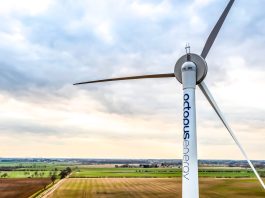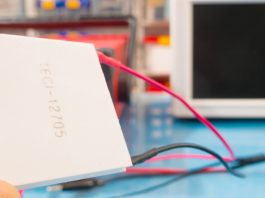Permanent magnet synchronous motors are making a statement in renewable energy developments. Jack Shaw, Writer and Editor at Modded, explores how they are benefiting the shift and what still needs work.
Permanent magnet synchronous motors (PMSMs) in electric drives are becoming increasingly popular as a replacement for conventional AC induction.
They are similar to brushless direct current motors because they have rotating electric motors with permanent wound stators and permanent electric rotors, but these solutions are energy efficient and do not produce any current.
How PMSMs work
Permanent magnet synchronous motors operate on the same principle as other synchronous motors. They start as squirrel cage motors, where the winding motors of the stator are energised by three-phase power to create a rotating magnetic field.
The stator is fixed, while the rotor with mounted magnets rotates without any field windings to create field poles. The stator layout allows the creation of a sinusoidal flux distribution in the air gap, which makes the back electromotive force sinusoidal.
Based on the stator’s design, PMSMs can be classified as distributed and concentrated windings. Their impressive performance, high power density and high torque combined with their smaller frame size make them suitable for a wide range of applications, including fans, blowers and pumps.
The permanent magnets are typically made up of highly permeable and rare earth magnets like samarium-cobalt, neodymium, praseodymium, terbium and dysprosium. When rotating at synchronous speed, the rotating electric motor magnetically locks with the stator poles to produce torque and allow the rotator to continue turning.
Depending on how the magnets are attached to the rotor, PMSMs can be classified into several categories, including surface permanent magnet synchronous motors, where all magnets are mounted on the rotor’s surface and interior permanent magnet synchronous motors, with the magnets inside the rotor.
Benefits of permanent magnet synchronous motors
The increasing adoption of permanent magnet synchronous motors can be attributed to the many advantages of the technology. These include:
- Energy cost savings: Energy efficiency is boosted by minimising energy losses created through constant magnetic fields, so they do not consume electric energy to produce the magnetic field.
- Dynamic and stable performance: PMSMs produce smooth torque and relatively high speeds and performance due to the synchronous high-speed rotating rotor, making them an excellent choice for high-speed applications and low-speed operations. High power-to-weight ratio increases overload capability, making them more stable than induction machines.
- Compact and lightweight: The motors are suitable for small-space installations, such as on EVs and small consumer electronics like smartphones and electric toothbrushes. This also results in smooth and quiet operation due to reduced vibrations and friction between brushes and mechanical collectors.
- Durability: PMSMs are long-lasting solutions for industrial and commercial applications thanks to their robust construction, and they’re safer in explosive or corrosive environments because they do not emit sparks.
- Low costs: Reduced energy consumption over the motor’s lifespan minimises operational expenses.
- Sustainability: The technology results in high levels of reliability and low maintenance due to the lack of brushes and mechanical switches. This increases sustainability and energy-efficient operations, helping organisations reduce their carbon footprints.
Limitations of PMSM technology
While PMSM technology is highly desirable, it may not be viable for every proposed application:
- Expenses: The initial cost of synchronous motors is higher than conventional motors due to the precision in construction and engineering.
- Limited speed control: PMSMs require a constant current supply to maintain the synchronous speed, meaning their speed cannot be changed easily.
PMSM applications in the renewable energy sector
PMSMs play a significant role in various parts of the renewable energy sector. Here are some that have been completely transformed.
Servo systems
PSMSs reduce core losses in servo systems to allow operation at high temperatures without degradation. They increase efficiency by replacing energy-consuming rotor windings common in traditional induction motors. The components also include high-performance insulation materials that can boost overall performance efficiency by over 90%, ensuring they outperform alternative motor technologies.
Electric vehicles
PMSMs are installed in electric and hybrid vehicles because of their high efficiency and power density. Interior permanent magnet synchronous motors are used in electric vehicles to boost their efficiency and minimise the need for external magnetic fields.
Embedding the motors internally increases mechanical stability and ensures the magnets don’t fly out. These permanent motors on the rotor and stator winding produce a rotating magnetic field that produces high power density, optimises performance and allows precise control.
They’re also preferred over AC induction motors because they deliver superior efficiency thanks to their smaller size and reduced weight. Manufacturers like Tesla, BMW and Nissan have embraced these advanced motors for some of their electric vehicles.
Wind power generators
The operational efficiency of PMSMs results in their adoption in wind power generators. Their high power density ensures they efficiently capture and convert electricity to support the harnessing of clean energy.
It also minimises conversion losses by reducing energy losses from heat and electromagnetic losses when using AC induction motors. PMSM wind power generators attain their peak efficiency at predefined wind speeds.
Industrial applications
PMSMs are integrated into industrial automation systems like conveyor belts and robotics to improve operational efficiency and boost the reliability of manufacturing processes. They may also be installed in other mechanical equipment that require high speed and efficiency, such as pumps, fans and compressors.
The motors are frequently adopted in large power systems where lagging and improved leading are necessary. Some examples include data storage units, aerospace, train drives and automobiles.
Consumer electronics
The motor’s energy efficiency, reliability and compact size make it a preferred choice for many home appliance manufacturers. They can integrate into electronics, refrigerators, vacuum cleaners, washing machines, mixers, grinders and air conditioners.
These motors reduce the power consumption of household appliances while improving their stability. Their compact size also enables their application in small consumer electronics such as smartphones, cameras, smartwatches and electric toothbrushes.
Adopt PMSM technology to boost efficiency
Incorporating PMSM technology into numerous complex automation and manufacturing processes will facilitate robust performance.
These motors can improve the performance, energy efficiency and reliability of different systems, including electric vehicles, consumer electronics, industrial applications, and wind and electricity generators.









